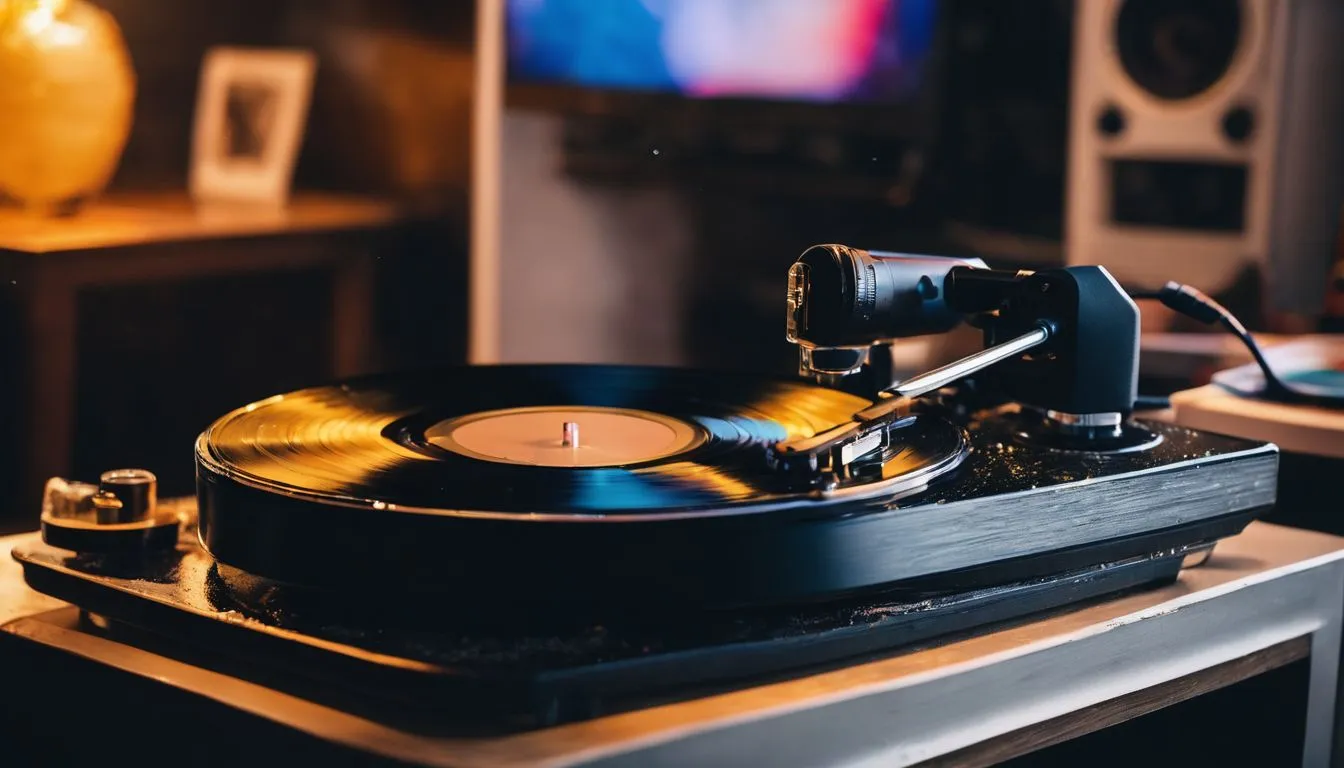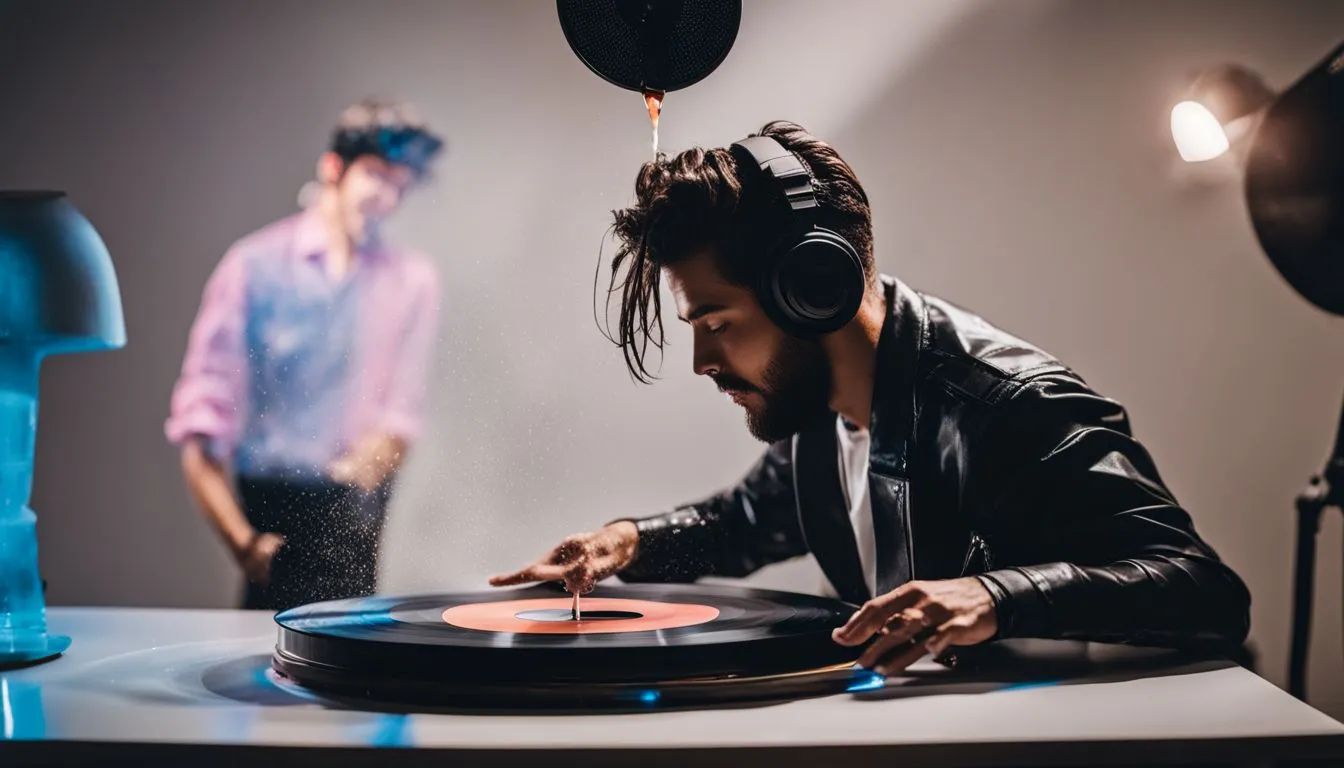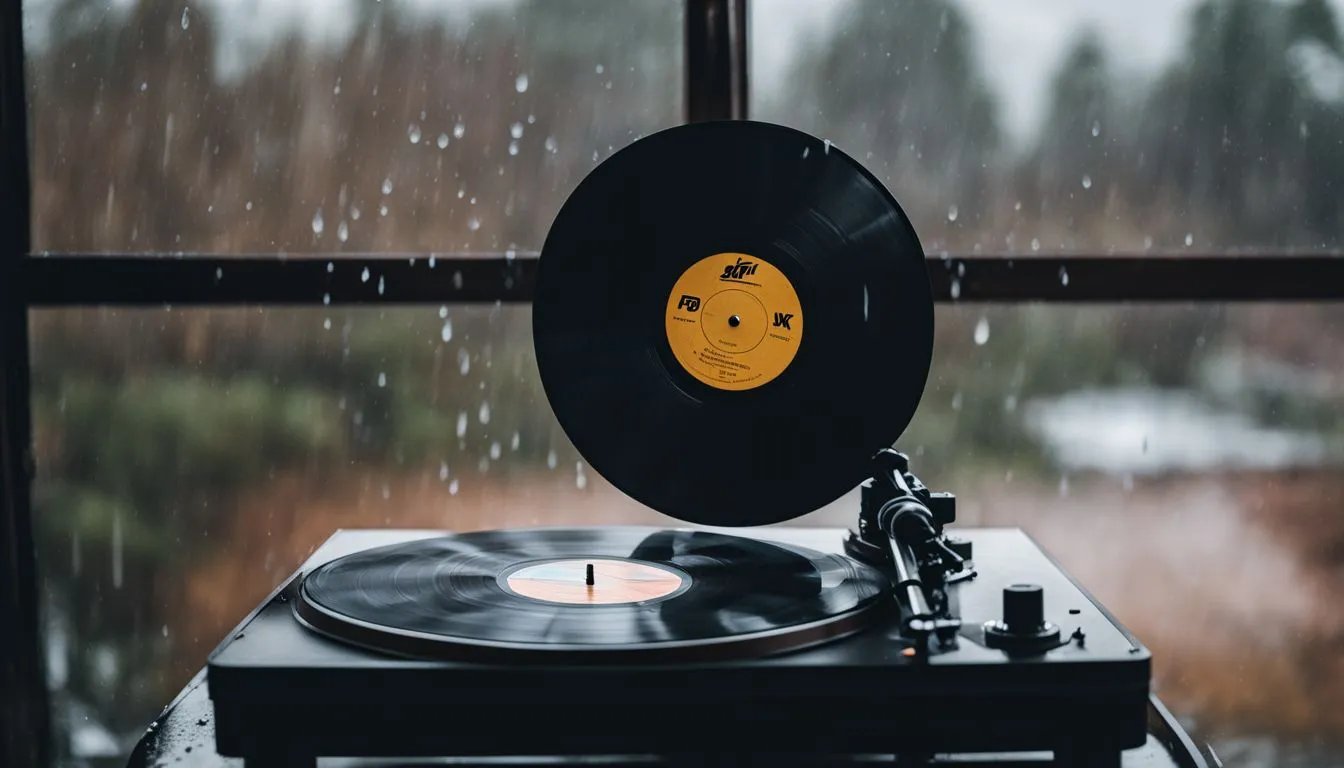Ever dusted off an old vinyl record and wondered if a splash of water could make it play smoother? You’re not alone; the practice of wet playing has stirred up quite a debate. Today, we’ll dive into the nitty-gritty of this technique, examining both its potential perks and pitfalls to guide you through your next spin session.
Keep reading—this might just change your tune on how to treat those treasured tracks.
Key Takeaways
- Playing records wet may lower static and dust, but it can damage grooves and wear out the stylus faster.
- Wet play could lead to corrosion or mold in record players over time, which is expensive to fix.
- For water-damaged vinyl, use distilled water and isopropyl alcohol for cleaning, then dry gently.
Understanding Wet Play of Records
Moving from the basic idea of playing records, let’s dive into what it means to play them wet. This method sprays a mixture of distilled water and other liquids onto the vinyl record before or during playback.
People do this in hopes of reducing static and keeping dust out of the grooves. The liquid acts as a lubricant, which can lower friction between the stylus and the vinyl surface.
However, some worry about what this moisture does in the long run. It might harm delicate parts like the magnetic cartridge, leading to costly repairs or replacements. Plus, if not done right, water can seep into tiny spaces where it shouldn’t be.
This could lead to corrosion or mold growth inside your record player’s components over time.
https://www.youtube.com/watch?v=L0He6FeT_7g
Theories on Wet Playing
The practice of wet playing has vinyl enthusiasts split—some swear by it, while others see it as a cardinal sin. Let’s dive into the undercurrents behind this contentious debate and explore just what happens when you introduce water to your turntable.
Advantages of Wet Playing
Playing records wet can be a game-changer for vinyl enthusiasts. It helps in reducing noise and enhancing sound quality. Let’s look at how it does this:
- Suspends dust and dirt: Wet playing lifts dust from the grooves of vinyl records. This cleaning action stops dirt from scratching the surface as the record spins.
- Damps vibrations: Water reduces vibrations caused by minor scratches. This makes the music sound clearer.
- Fills scratches: A wet play acts like a filler for scratches on your record. It smooths out the sound by bridging gaps in the vinyl.
- Improves sound quality: Wetting a record can make it sound better. As water fills in tiny spaces, it lets you hear more detail in your music.
- Uses special products: Items like GRUV-GLIDE and LENCOCLEAN work well for wet play. They clean and reduce noise at the same time.
Downsides of Wet Playing
Playing records wet might seem like a clever trick to get cleaner sound. Before you give it a try, understand the risks this method brings.
- Groove Damage: Adding liquids to your vinyl can act like sandpaper. The fluid and dirt together can scratch the delicate grooves.
- Stylus Strain: Your stylus, or needle, isn’t made for swimming. Water can increase wear and tear on this crucial part.
- Sound Distortion: Mixing liquids with electronics often leads to trouble. Wet play can mess with the sound quality, causing distortion.
- Clogged Cartridges: Liquids don’t always stay put. They can seep into the cartridge and gum up the works.
- Reduced Traction: The stylus needs to grip the record grooves just right. If things get slippery, the sound will suffer.
- Corrosion Concerns: Turntables are tough but not invincible. Wet playing may lead to corrosion in metal parts over time.
Impact of Wet Playing on Stylus Life
Playing records wet might seem like a good idea to reduce noise, but it can shorten the life of your stylus. Wet playing can leave behind residue from the liquid, which builds up on the styli over time.
This gunk affects how well the stylus tracks through grooves and may cause more record wear than you’d expect. The extra debris also means your stylus needs cleaning often, or worse, replacement sooner than you’d like.
Keeping your records and stylus dry helps them last longer. While a wet play may cut down on static and dust in the short term, it adds strain to the needle’s tip as it encounters uneven surfaces from leftover muck.
Dry playback avoids these issues altogether, making sure each groove stays crisp and clear without risking damage to your equipment or tunes.
Risks of Wet Playing
Diving into the risks of wet playing, you might be surprised to find that a splash of water could lead to more than just soggy labels—it’s a complex dance with your record’s condition and longevity; keep reading to uncover what’s at stake when moisture meets vinyl.
Potential for Clogging
Playing records while wet can trap dust and dirt in the grooves. This grime might clog up the record’s delicate patterns. Imagine dirt getting stuck and hardening over time; it blocks the clean sound you want.
Clogging not only muddles music but can also harm your stylus as it drags through the muck.
To keep things clear, using products designed for record cleaning can help. Options like GRUV-GLIDE or LENCOCLEAN are made to reduce surface tension and avoid this problem. They work by lifting debris from the grooves before it becomes an issue.
Keeping your records clean means a crisp sound and less wear on your equipment every time you play them.
Changes in Traction
Water alters how a record and stylus interact. The liquid can change the grip between the two, sometimes making it slip more. Imagine a car’s tires on a wet road; that’s similar to what happens with wet records.
This slippery action might lead to less control of the stylus as it tracks grooves.
A loss in traction means your music could sound off. The needle may skate over parts of the vinyl, causing tunes to warp or distort. It’s like listening through water—sounds may get fuzzy or lose their sharpness.
Keeping records dry helps keep your music clear and true to its original quality.
Possibility of Corrosion within Cartridges
Playing records wet could lead to corrosion inside your cartridge. Moisture may seep in, and over time, it can cause metal parts to rust. This is bad for the delicate components inside that need to move freely.
Corrosion might not happen right away, but repeated exposure increases the risk.
Using products like GRUV-GLIDE or LENCOCLEAN helps cut down on static and dust. These solutions keep your records clean while minimizing the chance of water getting into places it shouldn’t.
Still, be careful with any liquid around your turntable setup—it’s better to avoid a costly repair or replacement due to rust damage in your cartridge.
The Effect of Wet Playing on Vinyl Restoration and Archival
Wet playing can be tricky for vinyl restoration. Some collectors believe it helps clean the records and reduces surface noise. However, this method might not be safe for long-term preservation.
Water and cleaning fluids may seep into the tiny grooves of a record. Over time, these liquids could cause damage that’s hard to fix.
Using wet play often raises questions about archival practices, too. It leaves residues that build up on the record’s surface, affecting sound quality. For archivists who aim to keep vintage vinyl in top shape, dry methods are usually preferred.
They avoid introducing moisture that could lead to fungal growth or other issues down the line.
How to Restore Water-Damaged Records?
After discussing the effect of wet playing on vinyl preservation, let’s move on to fixing water-damaged records. It happens—your favorite vinyl gets a splash or takes an unexpected dive. Here’s a step-by-step guide to bring it back to life:
- Gently remove the record from its sleeve. Avoid touching the grooves with your fingers.
- Rinse the vinyl with distilled water. Tap water can leave minerals that damage the record.
- Create a cleaning solution by mixing one part isopropyl alcohol with three parts distilled water. Add a few drops of dish soap for extra cleaning power.
- Use a soft, lint-free cloth to apply the solution. Wipe in circular motions along the grooves, not across them.
- Carefully rinse off the cleaning mixture with more distilled water.
- Dry the record with another clean, soft cloth by dabbing or letting it air dry naturally, but keep it out of direct sunlight.
- Assess the record for any remaining residue or damage after it is completely dry.
- If there are stubborn spots, repeat the cleaning process only in those areas.
- Store your clean record in a new inner sleeve to avoid old contaminants getting back onto your vinyl.
Conclusion
Deciding to play a wet record is a personal choice. Think about the risks, like damage and wear to your stylus and records. Consider the benefits, such as less noise for old favorites.
If you choose to try it, use products made for this purpose. Remember, there’s no going back once the damage is done!
If you’re looking to restore water-damaged records, check out our guide on how to effectively restore your vinyl collection.
FAQs
1. Will playing a wet record damage it?
Yes, playing a wet record can cause damage—water isn’t vinyl’s friend.
2. Can I clean my records with water before playing them?
It’s best to use a proper record cleaning solution rather than plain water to avoid harm.
3. What if my record gets accidentally splashed with water while on the turntable?
Wipe your record gently with a soft, dry cloth immediately if it gets wet.
4. Is there any safe way to play a damp record?
Nope, you should always let your records fully dry before you spin them.
5. Does humidity in the air affect how records play?
Indeed, high humidity can warp records over time—it’s better to store and play them in drier conditions.


